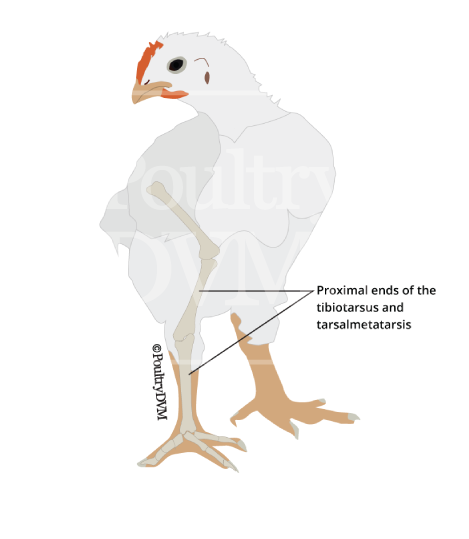Veterinary advice should be sought from your local veterinarian before applying any treatment or vaccine. Not sure who to use? Look up veterinarians who specialize in poultry using our directory listing. Find me a Vet
Other Names: Tibial Chondrodysplasia, Toxic Tibial Chondrodysplasia

| Name | Summary | |
|---|---|---|
| Supportive care | Isolate the bird from the flock and place in a safe, comfortable, warm location (your own chicken "intensive care unit") with easy access to water and food. Limit stress. Call your veterinarian. | |
| Vitamin D3 | Induces maturation of chondrocytes and improves bone quality. | Swiatkiewicz et al. 2006; Fritts and Waldroup 2003; Driver et al. (2006) |
| Icariin | 10 mg/kg/day in drinking water; icariin has a significant role in promoting the recovery of chicken growth plates affected by TD via regulating the P2RX7. | H Zhang et al., 2018 |
| Rhizoma (Rhizoma drynariae) dried root | 20 mg/kg can improve the growth performance of the TD chickens and recover normal activity. Gene expressions of BMP-2 and Runx2 were down-regulated during the development of the disease and were up-regulated obviously after treatment. | W Yao et al., 2018 |
| Naringin | 30 mg/kg; showed significant results by alleviating lameness, increased growth performance, recuperated growth plate (GP) width, and improved functions and antioxidant enzyme level of liver in broilers affected by TD. Moreover, naringin treatment restored the development of damaged tibia bone via downregulating Ihh and upregulating PTHrP mRNA and protein expressions. | X Jiang et al., 2020 |
| Meloxicam | In drinking water (0.5 mg/kg BW) | S Sooksong et al., 2017 |
| Feed management changes | The deleterious effects of the disease can be minimized if the bird's diet is restricted to two small meals a day, instead of being given constant access to feed. | |
| Weight management | The bird's weight should be continuously monitored to ensure their weight is controlled. | |
| Mobility Support | Provide a therapeutic support device, such as a sling, chicken wheelchair, etc. to help take some of the pressure off of their legs. |

© 2024 PoultryDVM All Rights Reserved.